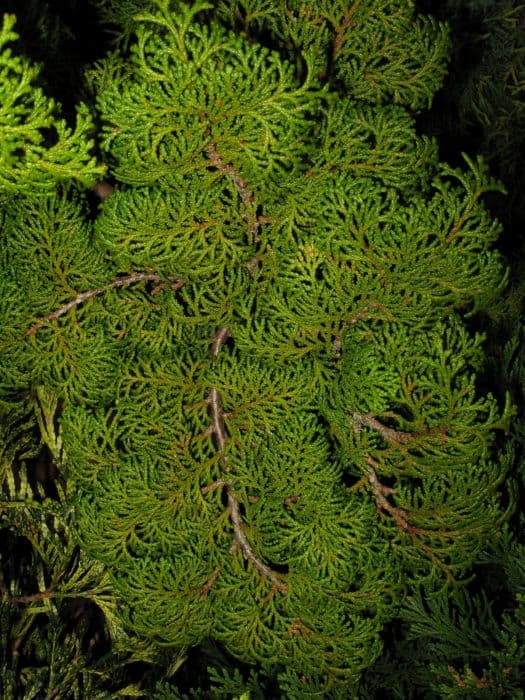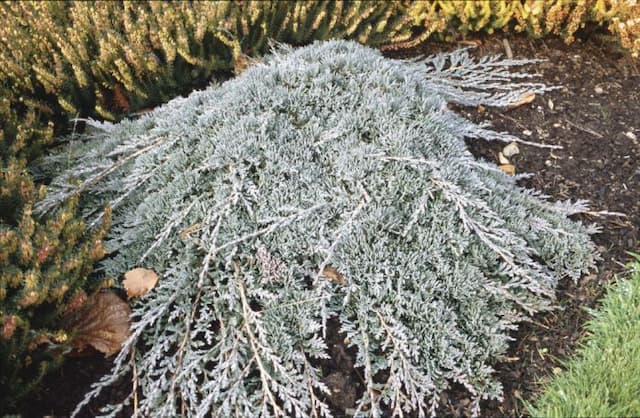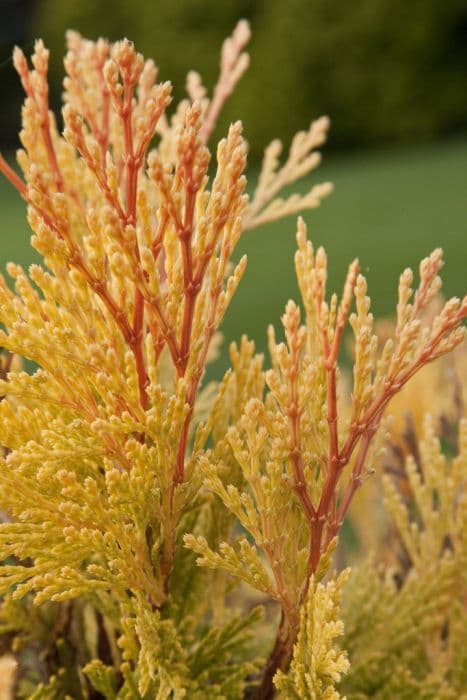Japanese Cedar Cryptomeria japonica 'Little Sonja'

ABOUT
Cryptomeria japonica 'Little Sonja' is a dwarf cultivar of the Japanese cedar that boasts a distinctive appearance. The foliage of this plant is fine and needle-like, offering a soft, feathery texture to the touch. It is dense and grows in attractive spirals that encircle the branches, adding a spiral-like pattern to its overall form. The leaves display a vibrant green hue, which can acquire bronzy undertones in the colder months, lending the plant a dynamic color shift through the seasons. What truly stands out about 'Little Sonja' is its overall form, which is compact and globe-shaped. This rounded habit makes it a versatile choice for many garden settings, where it can serve as a focal point without overpowering surrounding plants. The bark on the trunk and branches is reddish-brown, peeling away in vertical strips, which adds textural interest to the plant throughout the year, contrasting nicely with the plush green of the needles. Meanwhile, small, round cones may appear, usually less than an inch in diameter, providing a glimpse into the reproductive process of this conifer. These cones start out green and mature to a brown color as they age and dry out. In essence, 'Little Sonja' is cherished for its lush foliage, compact shape, and interesting textures, making it an attractive addition to a variety of landscape designs.
About this plant
 Names
NamesFamily
Cupressaceae.
Synonyms
Japanese Cedar, Sugi, Japanese Redwood.
Common names
Cryptomeria japonica 'Little Sonja'
 Toxicity
ToxicityTo humans
The Japanese cedar is generally not considered toxic to humans. There are no well-documented cases of poisoning from ingesting this plant. However, as with any non-food plant, ingesting plant material may potentially cause gastrointestinal upset or allergic reactions in some individuals.
To pets
The Japanese cedar is not commonly known to be toxic to pets. It is not listed as a toxic plant for dogs and cats by major animal health organizations. However, ingestion of non-food plants can sometimes lead to mild gastrointestinal upset in pets, such as vomiting or diarrhea. If a pet were to consume a large amount of the plant, it could potentially cause an obstruction or more serious gastrointestinal issues, but toxicity is not generally a concern with the Japanese cedar.
 Characteristics
CharacteristicsLife cycle
Perennials
Foliage type
Evergreen
Color of leaves
Green
Height
3 feet (0.91 meters)
Spread
2 feet (0.61 meters)
Plant type
Tree
Hardiness zones
5
Native area
Japan
Benefits
 General Benefits
General Benefits- Compact Size: Ideal for small gardens or limited spaces due to its small, dwarf form.
- Low Maintenance: Requires minimal pruning and care once established.
- Ornamental Value: Offers year-round visual interest with its dense, bright green foliage.
- Drought Tolerance: Can withstand periods of dryness when mature, reducing the need for frequent watering.
- Cold Hardy: Able to survive in colder climates, making it suitable for a range of environments.
- Adaptable: Tolerates a variety of soil types, though it prefers moist, well-drained soil.
- Erosion Control: Its root system can help stabilize the soil on slopes or in erosion-prone areas.
- Wildlife Support: Provides shelter for birds and other small wildlife.
- Seasonal Interest: Foliage may take on a bronze hue in the winter, adding seasonal color to the landscape.
 Medical Properties
Medical PropertiesThis plant is not used for medical purposes.
 Air-purifying Qualities
Air-purifying QualitiesThis plant is not specifically known for air purifying qualities.
 Other Uses
Other Uses- Miniature Bonsai Specimen: Due to the slow growth and small scale of Cryptomeria japonica 'Little Sonja', it is a favorite choice for creating miniature bonsai trees, providing a way to enjoy this beautiful conifer in a small indoor space.
- Craft Material: Thin, flexible branches of Cryptomeria japonica 'Little Sonja' can be harvested and used for crafting small wreaths or as material for basket weaving.
- Educational Tool: Schools and educational programs can use Cryptomeria japonica 'Little Sonja' to teach students about plant growth, conifer life cycles, and basic horticultural skills.
- Photography Subject: Its unique form and texture make Cryptomeria japonica 'Little Sonja' a popular subject for photographers, especially those interested in macro photography and plant portraits.
- Garden Sculpture: Trimmed and shaped over time, Cryptomeria japonica 'Little Sonja' can serve as a living sculpture in gardens, adding an element of artistry and creativity to the landscape.
- Fairy Gardens: Due to its small size, Cryptomeria japonica 'Little Sonja' is often used in the creation of fairy gardens, miniature garden scenes that inspire whimsy and imagination.
- Noise Barrier: When planted in dense rows, Cryptomeria japonica 'Little Sonja' can act as a noise barrier for small spaces, helping to reduce the intrusion of outside traffic or neighborhood sounds.
- Seasonal Decorations: Its evergreen foliage allows for Cryptomeria japonica 'Little Sonja' to be used in making seasonal decorations like holiday garlands and table centerpieces.
- Privacy Screening: In small urban gardens, Cryptomeria japonica 'Little Sonja' can be used to provide privacy without taking up too much space or requiring extensive pruning.
- Windbreaks for Delicate Plants: The thicker foliage of Cryptomeria japonica 'Little Sonja' can protect more delicate plants from harsh winds when planted strategically in a garden.
Interesting Facts
 Feng Shui
Feng ShuiThe Japanese Cedar is not used in Feng Shui practice.
 Zodiac Sign Compitability
Zodiac Sign CompitabilityThe Japanese Cedar is not used in astrology practice.
 Plant Symbolism
Plant Symbolism- Longevity: The Cryptomeria japonica, commonly known as Japanese Cedar, is known for its long lifespan, symbolizing endurance and the passage of time.
- Strength: Its wood is sturdy and rot-resistant, making the Japanese Cedar a symbol of strength and resilience.
- Sacredness: In Japan, this tree is often associated with sacred Shinto shrines, representing purity and eternal spirit.
- Peace: The tree's evergreen nature and association with serene landscapes position it as a symbol of tranquility and peace.
 Water
WaterThe Japanese Cedar 'Little Sonja' should be watered regularly, generally once a week, with increased frequency during hot, dry periods. It's essential to keep the soil consistently moist but not waterlogged. Deep watering is preferred to encourage root growth, so applying about 1 to 1.5 gallons of water at each session should suffice, depending on the size of the plant and the weather conditions. In winter, water less frequently, but do not allow the soil to completely dry out. Overwatering can lead to root rot, so ensure proper drainage.
 Light
LightJapanese Cedar 'Little Sonja' thrives best in full sun to partial shade. It should be placed in a location where it can receive at least four hours of direct sunlight daily, with some protection from the intense, hot afternoon sun if possible. Dappled sunlight beneath the canopy of taller trees is also suitable for this plant, helping it avoid scorching during peak sun exposure.
 Temperature
TemperatureJapanese Cedar 'Little Sonja' can handle a range of temperatures but prefers a cooler climate. It is hardy and can survive temperatures as low as -20°F but thrives in an environment where the temperature tends to stay between 60°F and 70°F. Sudden temperature drops below freezing can cause some damage to new growth, so it is best situated in a location protected from harsh winter winds.
 Pruning
PruningPruning of Japanese Cedar 'Little Sonja' is generally for shaping and removing any dead or diseased branches. The best time to prune is in the late winter or early spring before new growth begins. Lightly shape the plant to maintain its natural pyramidal form, cutting back any stray branches. It is not necessary to prune annually; doing so every other year or as needed to control size is often enough.
 Cleaning
CleaningAs needed
 Soil
SoilThe best soil mix for Japanese Cedar 'Little Sonja' is well-draining, acidic to neutral, ideally with a pH between 5.0 and 7.0. A mix of peat, pine bark, and coarse sand or perlite is suitable for healthy growth.
 Repotting
RepottingJapanese Cedar 'Little Sonja' should be repotted every 2-3 years, or when it becomes root-bound. Younger trees may require more frequent repotting, but this should be done in late winter or early spring.
 Humidity & Misting
Humidity & MistingJapanese Cedar 'Little Sonja' thrives in moderate to high humidity levels, preferably between 50% and 70%. Adequate air circulation is also important to prevent fungal diseases.
 Suitable locations
Suitable locationsIndoor
Place in bright, indirect light, and ensure good humidity.
Outdoor
Plant in well-draining soil, partial to full sun, sheltered from strong winds.
Hardiness zone
5-9 USDA
 Life cycle
Life cycleJapanese Cedar 'Little Sonja' begins life as a seed, which germinates in spring when soil temperatures and moisture levels are suitable. It then develops into a seedling, with the first leaves, known as cotyledons, emerging to start photosynthesis. As the plant grows, it enters the juvenile phase, characterized by rapid growth and the development of its distinctive needle-like foliage. The Japanese Cedar 'Little Sonja' reaches maturity after several years, developing a conical shape and beginning reproductive cycle, producing male and female cones on the same plant through a process known as monoecy. Pollination occurs typically in the late winter to spring, with wind transferring pollen from male cones to female cones. After pollination and fertilization, seeds develop within the female cones and, once mature, are dispersed to start a new cycle, while the mature plant continues to grow and produce cones annually.
 Propogation
PropogationPropogation time
Spring-Early Summer
Cryptomeria japonica 'Little Sonja', commonly known as Japanese Cedar, is typically propagated through semi-hardwood cuttings. The best time to take these cuttings is in late summer to early autumn. To propagate, a healthy non-flowering stem should be selected, and a cutting of about 4 to 6 inches (10 to 15 centimeters) is made just below a node. The lower third of the cutting should be stripped of foliage, and the cut end can be dipped in rooting hormone powder to encourage root growth. The prepared cutting is then placed into a pot containing a mixture of peat and perlite or sand, ensuring good contact between the cutting and the medium. The pot should be kept in a warm spot with indirect sunlight and maintained moist. Rooting can take several weeks, during which a plastic bag or a propagation dome can be used to help retain humidity around the cutting.









